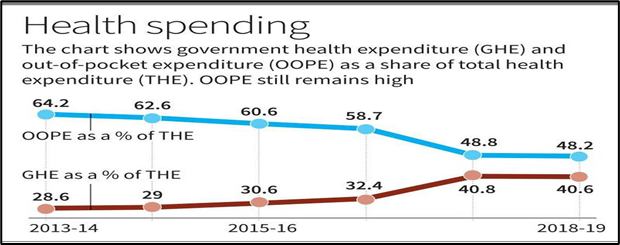Why in News?
- According to the recently released Economic Survey 2022-23, almost half of all health spending in India is still paid by patients themselves, although this has dropped as the government’s share of spending on health went up significantly after 2013-14.
- While the expenditure on social services increased from ₹9,15,500 to ₹21,32,059 crore, the budgetary allocation for education as a percentage of total expenditure has dropped over the past seven years, from 10.4% to 9.5%.
What’s in Today’s Article?
- What is the Scenario of the Health Sector in India?
- What is the Scenario of the Education Sector in India?
What is the Scenario of the Health Sector in India?

- Increase in the share of government health expenditure: It was just 28.6% (in comparison to the total health expenditure) in the financial year 2013-14, but rose to 6% by 2018-19.
- For 2018-19, India’s total health expenditure was estimated to be ₹5,96,440 crore (current + capital expenditures by the govt, private sources including external funds), which is 2% of GDP and amounts to ₹4,470 per capita.
- India’s budgeted expenditure on the health sector reached 2.1% of the GDP in financial year 2023 (Budget estimates) and 2.2% in FY 2022 (revised estimates).
- This is closer to the recommendations (2.5% by 2025) made in the National Health Policy 2017 as well as the 15th Finance Commission.
- Decline in out-of-pocket expenditure: Consequently, it declined as a percentage of total health expenditure from 64.2% in 2013-14 to 48.2% in 2018-19.
- Out-of-pocket expenditure is the money paid directly by households, at the point of receiving health care.
- Increase in the share of health expenditure in total expenditure on social services: It has increased from 21% in FY 2019 to 26% in FY 2023 (BE).
- This underscores the rising importance of public healthcare and social security in ensuring universal health coverage.
- One of the major factors for this increase is the expenditure incurred in the national Covid-19 vaccination programme (97% have received both the doses).
- Ayushman Bharat Jan Arogya Yojana (AB-JAY) falling short of the target:
- Under the Union Health Ministry’s largest cashless health insurance scheme, approximately 21.9 crore beneficiaries have been verified, including 3 crore beneficiaries verified using State IT systems.
- This is less than 50% of the originally targeted approximately 50 crore beneficiaries under the scheme.
- The rate of overweight children (under 5) and men-women has gone up:
- According to the National Family Health Survey, for children it has gone up from 2.1% in 2015-16 to 3.4% in 2019-21.
- Similarly, the number of women who are overweight or obese has increased from 20.6% to 24%, while the number of men has gone up from 18.9% to 22.9%.
What is the Scenario of the Education Sector in India?

- Decline in the govt share of expenditure:
- The share of education expenditure within the social services umbrella category shrank from 42.8% to 35.5% between 2015-2016 and 2022-2023, mainly due to the faster growth in spending on health and other measures.
- As a share of total GDP, the budgetary allocation for education saw only a minimal gain of 0.1 percentage points, from 2.8% to 2.9% during the same seven-year period.
- COVID worsens dropout rates:
- Though school dropout rates have improved since 2013-2014, there has been some reversal of gains since COVID-19.
- The total dropout rate in primary school was 0.8% in 2020-2021 but rose back to 1.5% in 2021-2022 (significantly better than the 4.7% dropout rate in 2013-2014).
- In upper primary classes, the dropout rate was 2.3% in the year 2020-21, but rose to 3% in 2021-2022, only marginally lower than the 3.1% level seen in 2013-2014.
- In the secondary classes, however, the situation has steadily improved, with the dropout rate falling from 16.1% in 2019-2020 to 14% the following year and 12.6% last year.
- Number of schools:
- Between 2013-2014 and 2021-2022, the total number of schools declined from 15.2 lakh to 14.9 lakh.
- Though the number of secondary and senior secondary schools rose.
- Higher education enrolment up:
- The total enrolment in higher education has increased to nearly 4.1 crore in financial year 2020-21 from 3.9 crore in 2019-20.
- Since 2014-15, there has been an increase of around 72 lakh or 21% in enrolment, while distance education has also grown at a similar rate of 20%.
- Number of higher education institutions:
- As far as higher education is concerned, the number of medical colleges in the country increased from 387 in 2014 to 648 in 2022.
- The number of Indian Institutes of Technology (IITs) rose from 16 to 23 between 2014 and 2022 and Indian Institutes of Management (IIMs) increased from 13 to 20.
- The strength of Indian Institutes of Information Technology (IIITs) was 25 in 2022 against 9 in 2014.
- In 2014, there were 723 Universities in the country, which have increased to 1,113.









